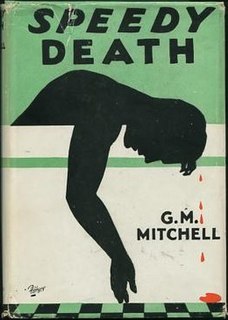
Speedy Death is a 1929 mystery detective novel by the British writer Gladys Mitchell. It introduced the character of Mrs Bradley who would go on to appear in a further sixty five novels. The title is sometimes written as A Speedy Death.

Groaning Spinney is a 1950 mystery detective novel by the British writer Gladys Mitchell. It is the twenty third in her long-running series featuring the psychoanalyst and amateur detective Mrs Bradley. It was later republished under the title of Murder in the Snow.

Dead Men's Morris is a 1936 mystery detective novel by the British writer Gladys Mitchell. It is the seventh in her long-running series featuring the psychoanalyst and amateur detective Mrs Bradley. It was the first to be published by Michael Joseph who released all the subsequent fifty nine novels in the series. It was later republished with the alternative title Death Comes at Christmas.
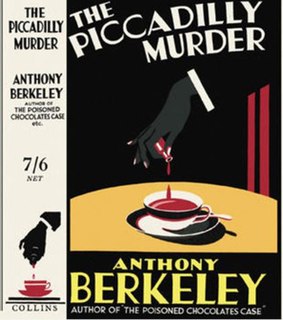
The Piccadilly Murder is a 1929 mystery detective novel by the British writer Anthony Berkeley. Berkley was a prominent writer during the Golden Age of Detective Fiction, known for his private detective Roger Sheringham series and his development of the inverted detective story. Although not part of the Sheringham series it featured the character of Chief Inspector Moresby of Scotland Yard who also appeared several times with Sheringham. Moresby reappeared with the chief protagonist Chitterwick in a sequel Trial and Error in 1937.

The Man Who Wasn't There is a 1937 mystery detective novel by Anthony Gilbert, the pen name of British writer Lucy Beatrice Malleson. It is the second in her long-running series featuring the unscrupulous London solicitor and detective Arthur Crook.

Murder Has No Tongue is a 1937 mystery detective novel by Anthony Gilbert, the pen name of British writer Lucy Beatrice Malleson. It is the third in her long-running series featuring the unscrupulous London solicitor and detective Arthur Crook.
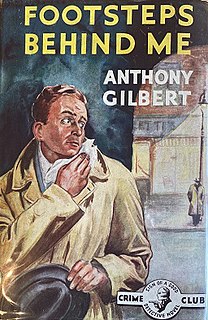
Footsteps Behind Me is a 1953 mystery detective novel by Anthony Gilbert, the pen name of British writer Lucy Beatrice Malleson. It is the twenty seventh in her long-running series featuring the unscrupulous solicitor and detective Arthur Crook. Crook first appeared during the Golden Age of Detective Fiction, but the series ran for several decades. It was published in the United States under the alternative title Black Death.

The Musical Comedy Crime is a 1933 mystery detective novel by Anthony Gilbert, the pen name of British writer Lucy Beatrice Malleson. It is the seventh entry of the series featuring Scott Egerton, her principal character before her better known creation Arthur Crook appeared three years later. A traditional whodunnit, it was published during the Golden Age of Detective Fiction.
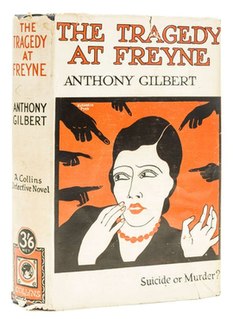
The Tragedy at Freyne is a 1927 mystery detective novel by Anthony Gilbert, the pen name of British writer Lucy Beatrice Malleson. Her first novel under the pseudonym, it introduced the amateur detective Scott Egerton who was her principle character until the creation of Arthur Crook in Murder by Experts.
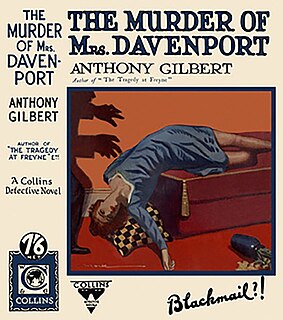
The Murder of Mrs. Davenport is a 1928 mystery detective novel by Anthony Gilbert, the pen name of British writer Lucy Beatrice Malleson. It was the second novel featuring her amateur detective Scott Egerton.

The Mystery of the Open Window is a 1929 mystery detective novel by Anthony Gilbert, the pen name of British writer Lucy Beatrice Malleson. It is the fourth novel in a series featuring her amateur detective, the politician Scott Egerton. Unlike the rest of the series it was published by Gollancz rather than Collins. It takes the form of a locked room mystery, a popular branch of the genre during the Golden Age of Detective Fiction.

The Night of the Fog is a 1930 mystery detective novel by Anthony Gilbert, the pen name of British writer Lucy Beatrice Malleson. It is the fifth of ten novels in a series featuring her amateur detective and politician Scott Egerton, a precursor to her better known creation Arthur Crook.

The Body on the Beam is a 1932 mystery detective novel by Anthony Gilbert, the pen name of British writer Lucy Beatrice Malleson. It is the sixth of ten novels in a series featuring her amateur detective and politician Scott Egerton, a precursor to her better known creation Arthur Crook.

An Old Lady Dies is a 1934 mystery detective novel by Anthony Gilbert, the pen name of British writer Lucy Beatrice Malleson. It is the ninth of ten novels in a series featuring her amateur detective and politician Scott Egerton, a precursor to her better known creation Arthur Crook. It was reviewed in the Sunday Times by Dorothy L. Sayers.

The Man Who Was Too Clever is a 1935 mystery detective novel by Anthony Gilbert, the pen name of British writer Lucy Beatrice Malleson. It is the tenth and last in a series of novels featuring her amateur detective and politician Scott Egerton. The following year she introduced a new character, the unscrupulous solicitor Arthur Crook, in Murder by Experts.
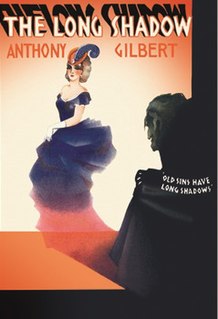
The Long Shadow is a 1932 mystery detective novel by Anthony Gilbert, the pen name of British writer Lucy Beatrice Malleson. It is the seventh of ten novels in a series featuring her amateur detective and politician Scott Egerton, a precursor to her better known creation Arthur Crook.

Miss Pinnegar Disappears is a 1952 mystery detective novel by Anthony Gilbert, the pen name of British writer Lucy Beatrice Malleson. It is the twenty sixth in her long-running series featuring the unscrupulous solicitor and detective Arthur Crook. Crook first appeared during the Golden Age of Detective Fiction, but the series ran for several decades. It was published in the United States under the alternative title A Case for Mr. Crook.

Antidote to Venom is a 1938 detective novel by the Irish-born novelist Freeman Wills Crofts. It is the eighteenth in his series of novels featuring Inspector French, a Scotland Yard detective known for his methodical technique. It was reissued in 2015 by the British Library Publishing as part of a group of crime novels from the Golden Age of Detective Fiction.

The House on Tollard Ridge is a 1929 detective novel by John Rhode, the pen name of the British writer Cecil Street. It marked the sixth appearance of the armchair detective Lancelot Priestley, who featured in a long-running series of novels during the Golden Age of Detective Fiction. The plot was partly inspired by Rudyard Kipling's short story Wireless, which Rhode mentions in the novel.
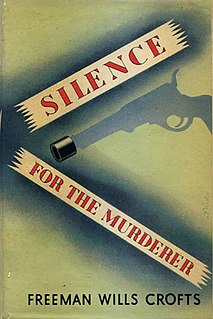
Silence for the Murderer is a 1949 detective novel by the writer Freeman Wills Crofts. It is the twenty seventh entry in his series of novels featuring Inspector French, a Scotland Yard detective of the Golden Age known for his methodical technique. The book attempt to create more complex characterisation than was usual in the series.




















